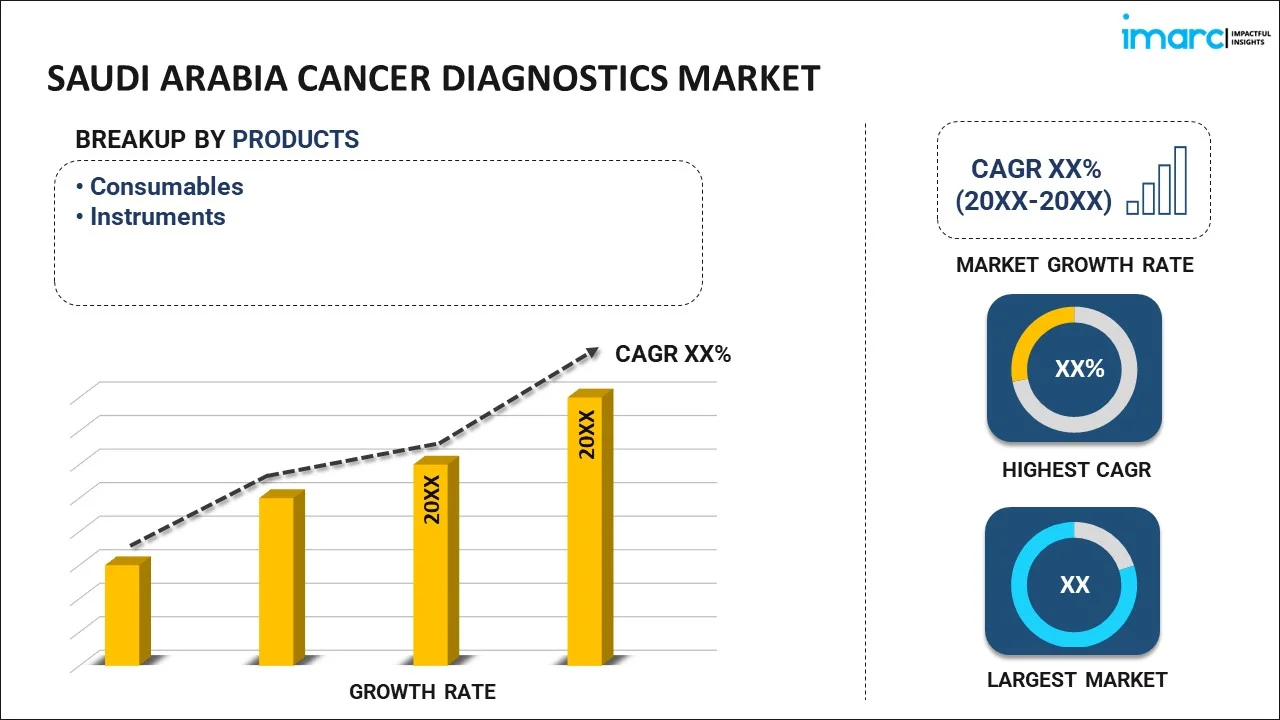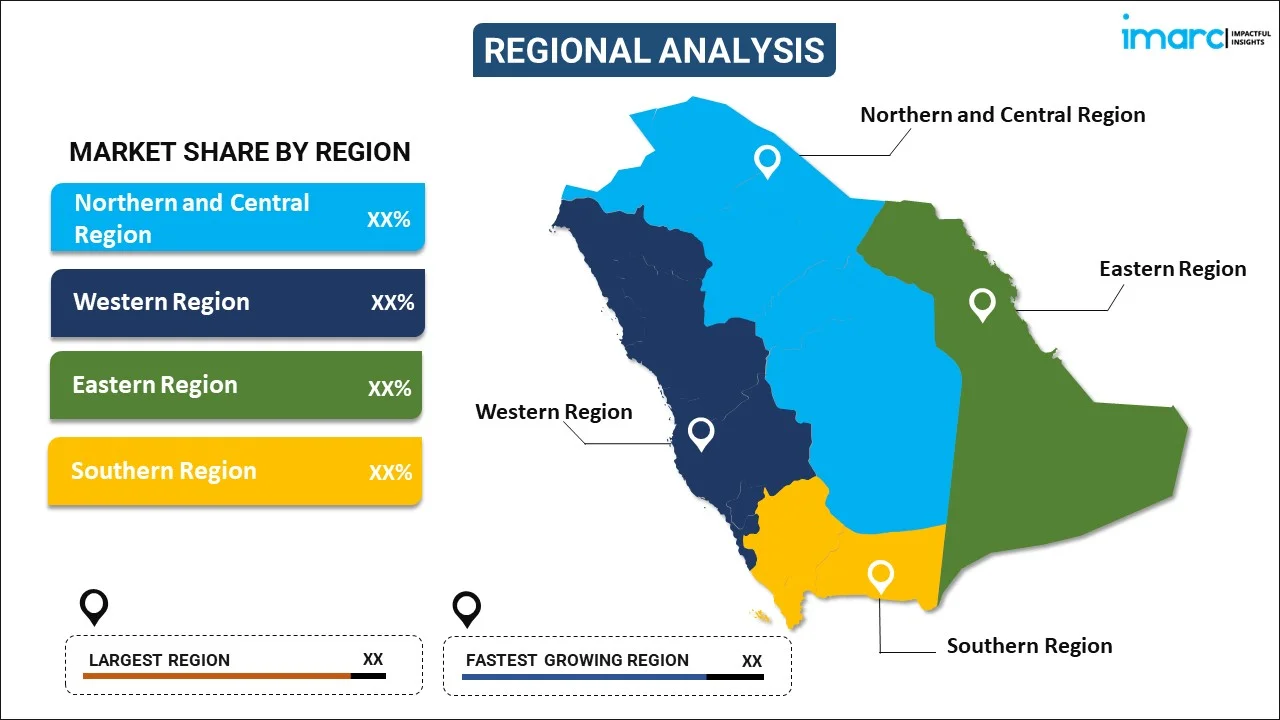
Saudi Arabia Cancer Diagnostics Market Report by Product (Consumables, Instruments), Technology (IVD Testing, Imaging, Biopsy Technique), Application (Breast Cancer, Lung Cancer, Colorectal Cancer, Melanoma, and Others), End User (Hospitals and Clinics, Diagnostic Laboratories, and Others), and Region 2024-2032
Market Overview:
Saudi Arabia cancer diagnostics market size is projected to exhibit a growth rate (CAGR) of 8.32% during 2024-2032. The widespread adoption of this personalized approach that contributes to enhanced therapeutic strategies, fostering better patient outcomes and overall healthcare efficacy, is primarily driving the market growth.
|
Report Attribute
|
Key Statistics
|
|---|---|
|
Base Year
|
2023 |
|
Forecast Years
|
2024-2032 |
|
Historical Years
|
2018-2023
|
| Market Growth Rate (2024-2032) | 8.32% |
Cancer diagnostics involves identifying and ascertaining the existence, nature, and stage of cancer in individuals. This field encompasses various methods and technologies, including magnetic resonance imaging (MRI), X-rays, and laboratory examinations, which analyze blood, tissue, and genetic samples. Through these diagnostic approaches, healthcare professionals can precisely identify and evaluate cancerous developments within the body. Additionally, cancer diagnostics empower healthcare providers to refine patient outcomes by customizing interventions based on the specific attributes of the disease. This process aids in improving treatment decisions and formulating personalized therapeutic approaches.
Saudi Arabia Cancer Diagnostics Market Trends:
The cancer diagnostics market in Saudi Arabia is witnessing significant growth and transformation, aligning with the nation's commitment to advancing healthcare infrastructure and services. Cancer diagnostics, a crucial aspect of healthcare, plays a pivotal role in identifying and characterizing cancer in individuals, facilitating timely and effective treatment interventions. Additionally, the regional market encompasses a diverse range of advanced techniques and technologies. Magnetic resonance imaging (MRI), X-rays, and sophisticated laboratory tests analyzing blood, tissue, and genetic samples are integral components of the diagnostic landscape. These technologies enable healthcare professionals to precisely detect and assess cancerous growths, aiding in the formulation of comprehensive and tailored treatment strategies. Besides this, the focus on cancer diagnostics in Saudi Arabia is not only geared towards early detection but also extends to the optimization of patient outcomes. Moreover, by leveraging advanced diagnostic tools, healthcare providers can gain insights into the specific characteristics and staging of cancer, allowing for more informed treatment decisions. Apart from this, as Saudi Arabia continues to invest in healthcare infrastructure and research, the cancer diagnostics market is poised for further expansion. Collaborations between healthcare institutions, technological advancements, and a growing emphasis on preventive healthcare contribute to the continuous evolution of cancer diagnostics in the country. Furthermore, the commitment to improving diagnostic capabilities reflects Saudi Arabia's dedication to offering world-class healthcare services and addressing the evolving healthcare needs of its population. This, in turn, is expected to fuel the market growth in the coming years.
Saudi Arabia Cancer Diagnostics Market Segmentation:
IMARC Group provides an analysis of the key trends in each segment of the market, along with forecasts at the country level for 2024-2032. Our report has categorized the market based on product, technology, application, and end user.
Product Insights:

- Consumables
- Antibodies
- Kits and Reagents
- Probes
- Others
- Instruments
- Pathology-based Instruments
- Imaging Instruments
- Biopsy Instruments
The report has provided a detailed breakup and analysis of the market based on the product. this includes consumables (antibodies, kits and reagents, probes, and others) and instruments (pathology-based instruments, imaging instruments, and biopsy instruments).
Technology Insights:
- IVD Testing
- Polymerase Chain Reaction (PCR)
- In Situ Hybridization (ISH)
- Immunohistochemistry (IHC)
- Next-generation Sequencing (NGS)
- Microarrays
- Flow Cytometry
- Immunoassays
- Others
- Imaging
- Magnetic Resonance Imaging (MRI)
- Computed Tomography (CT)
- Positron Emission Tomography (PET)
- Mammography
- Ultrasound
- Biopsy Technique
A detailed breakup and analysis of the market based on the technology have also been provided in the report. This includes IVD testing (polymerase chain reaction (PCR), in situ hybridization (ISH), immunohistochemistry (IHC), next-generation sequencing (NGS), microarrays, flow cytometry, immunoassays, and others), imaging (magnetic resonance imaging (MRI), computed tomography (CT), positron emission tomography (PET), mammography, and ultrasound), and biopsy technique.
Application Insights:
- Breast Cancer
- Lung Cancer
- Colorectal Cancer
- Melanoma
- Others
The report has provided a detailed breakup and analysis of the market based on the application. This includes breast cancer, lung cancer, colorectal cancer, melanoma, and others.
End User Insights:
- Hospitals and Clinics
- Diagnostic Laboratories
- Others
A detailed breakup and analysis of the market based on the end user have also been provided in the report. This includes hospitals and clinics, diagnostic laboratories, and others.
Regional Insights:

- Northern and Central Region
- Western Region
- Eastern Region
- Southern Region
The report has also provided a comprehensive analysis of all the major regional markets, which include Northern and Central Region, Western Region, Eastern Region, and Southern Region.
Competitive Landscape:
The market research report has also provided a comprehensive analysis of the competitive landscape in the market. Competitive analysis such as market structure, key player positioning, top winning strategies, competitive dashboard, and company evaluation quadrant has been covered in the report. Also, detailed profiles of all major companies have been provided.
Saudi Arabia Cancer Diagnostics Market Report Coverage:
| Report Features | Details |
|---|---|
| Base Year of the Analysis | 2023 |
| Historical Period | 2018-2023 |
| Forecast Period | 2024-2032 |
| Units | US$ Million |
| Scope of the Report | Exploration of Historical Trends and Market Outlook, Industry Catalysts and Challenges, Segment-Wise Historical and Future Market Assessment:
|
| Products Covered |
|
| Technologies Covered |
|
| Applications Covered | Breast Cancer, Lung Cancer, Colorectal Cancer, Melanoma, Others |
| End Users Covered | Hospitals and Clinics, Diagnostic Laboratories, Others |
| Regions Covered | Northern and Central Region, Western Region, Eastern Region, Southern Region |
| Customization Scope | 10% Free Customization |
| Report Price and Purchase Option | Single User License: US$ 3699 Five User License: US$ 4699 Corporate License: US$ 5699 |
| Post-Sale Analyst Support | 10-12 Weeks |
| Delivery Format | PDF and Excel through Email (We can also provide the editable version of the report in PPT/Word format on special request) |
Key Questions Answered in This Report:
- How has the Saudi Arabia cancer diagnostics market performed so far and how will it perform in the coming years?
- What has been the impact of COVID-19 on the Saudi Arabia cancer diagnostics market?
- What is the breakup of the Saudi Arabia cancer diagnostics market on the basis of product?
- What is the breakup of the Saudi Arabia cancer diagnostics market on the basis of technology?
- What is the breakup of the Saudi Arabia cancer diagnostics market on the basis of application?
- What is the breakup of the Saudi Arabia cancer diagnostics market on the basis of end user?
- What are the various stages in the value chain of the Saudi Arabia cancer diagnostics market?
- What are the key driving factors and challenges in the Saudi Arabia cancer diagnostics?
- What is the structure of the Saudi Arabia cancer diagnostics market and who are the key players?
- What is the degree of competition in the Saudi Arabia cancer diagnostics market?
Key Benefits for Stakeholders:
- IMARC’s industry report offers a comprehensive quantitative analysis of various market segments, historical and current market trends, market forecasts, and dynamics of the Saudi Arabia cancer diagnostics market from 2018-2032.
- The research report provides the latest information on the market drivers, challenges, and opportunities in the Saudi Arabia cancer diagnostics market.
- Porter's five forces analysis assist stakeholders in assessing the impact of new entrants, competitive rivalry, supplier power, buyer power, and the threat of substitution. It helps stakeholders to analyze the level of competition within the Saudi Arabia cancer diagnostics industry and its attractiveness.
- Competitive landscape allows stakeholders to understand their competitive environment and provides an insight into the current positions of key players in the market.
Need more help?
- Speak to our experienced analysts for insights on the current market scenarios.
- Include additional segments and countries to customize the report as per your requirement.
- Gain an unparalleled competitive advantage in your domain by understanding how to utilize the report and positively impacting your operations and revenue.
- For further assistance, please connect with our analysts.
 Inquire Before Buying
Inquire Before Buying
 Speak to an Analyst
Speak to an Analyst
 Request Brochure
Request Brochure
 Request Customization
Request Customization




.webp)




.webp)












